The Intel Broadwell Desktop Review: Core i7-5775C and Core i5-5675C Tested (Part 1)
by Ian Cutress on June 2, 2015 7:45 AM ESTOffice Performance
The dynamics of CPU Turbo modes, both Intel and AMD, can add a wrinkle to testing in environments with a variable threaded workload. There is also an added issue of the motherboard remaining consistent, depending on how the motherboard manufacturer wants to add in their own boosting technologies over the ones that Intel would prefer they used. In order to remain consistent, we implement an OS-level unique high performance mode on all the CPUs we test which should override any motherboard manufacturer performance mode.
All of our benchmark results can also be found in our benchmark engine, Bench.
Dolphin Benchmark: link
Many emulators are often bound by single-threaded CPU performance, and general reports tended to suggest that Haswell provided a significant boost to emulator performance. This benchmark runs a Wii program that raytraces a complex 3D scene inside the Dolphin Wii emulator. Performance on this benchmark is a good proxy of the speed of Dolphin CPU emulation, which is an intensive single core task using most aspects of a CPU. Results are given in minutes, where the Wii itself scores 17.53 minutes.
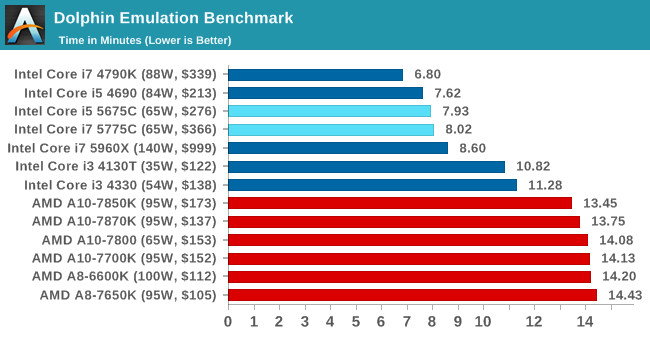
Crystal Well doesn’t help much in Dolphin, indicating it is more CPU frequency limited than DRAM/cache limited.
WinRAR 5.0.1: link
Our WinRAR test from 2013 is updated to the latest version of WinRAR at the start of 2014. We compress a set of 2867 files across 320 folders totaling 1.52 GB in size – 95% of these files are small typical website files, and the rest (90% of the size) are small 30 second 720p videos.
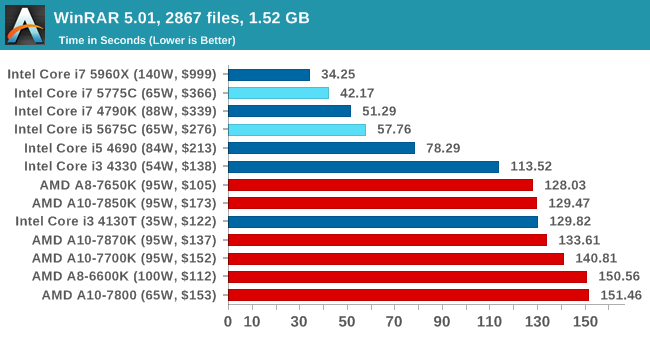
WinRAR is our typical benchmark to go to when testing whether DRAM is factor, and the improvements provided by the Crystal Well implementation trump any frequency deficit.
3D Particle Movement
3DPM is a self-penned benchmark, taking basic 3D movement algorithms used in Brownian Motion simulations and testing them for speed. High floating point performance, MHz and IPC wins in the single thread version, whereas the multithread version has to handle the threads and loves more cores.
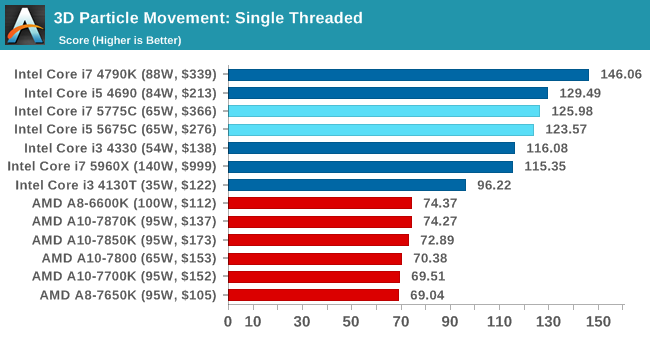
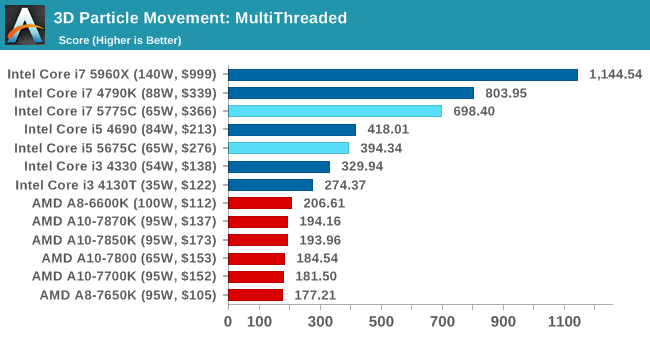
3DPM, like Dolphin, is concerned more with CPU frequency than DRAM accesses.
FastStone Image Viewer 4.9
FastStone is the program I use to perform quick or bulk actions on images, such as resizing, adjusting for color and cropping. In our test we take a series of 170 images in various sizes and formats and convert them all into 640x480 .gif files, maintaining the aspect ratio. FastStone does not use multithreading for this test, and results are given in seconds.
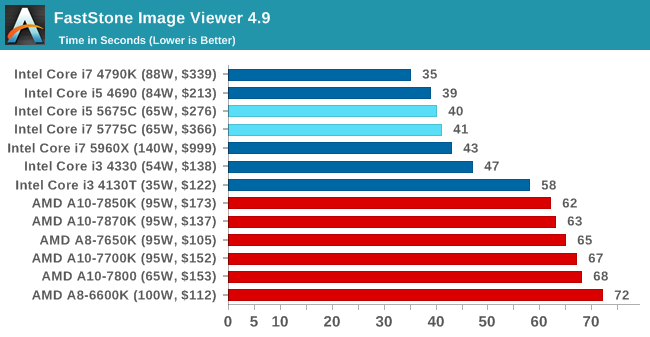
Web Benchmarks
On the lower end processors, general usability is a big factor of experience, especially as we move into the HTML5 era of web browsing. For our web benchmarks, we take four well known tests with Chrome 35 as a consistent browser.
Mozilla Kraken 1.1
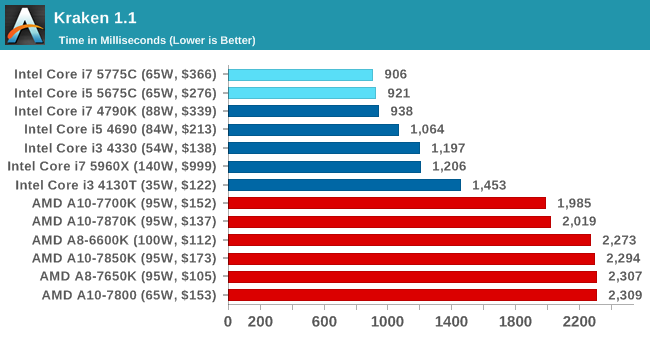
WebXPRT
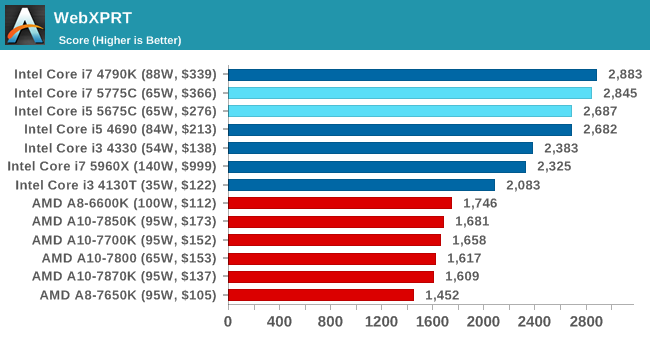
Google Octane v2

In the webtests, the Broadwell-DT CPUs didn’t necessarily take top spot but they are punching above their expected weight for their frequency.










196 Comments
View All Comments
iTon - Saturday, June 6, 2015 - link
i've think AMD products best when used Mantle API. it can boost up to 30% than DirectX API. Otherwise 10% parts of AMD APU had TrueAudio DSP Processor. so it is not 100% CPU and GPUOxford Guy - Saturday, June 6, 2015 - link
Six APUs and not one FX chip in the charts.LAME
Oxford Guy - Saturday, June 6, 2015 - link
Heaven forbid someone might see that you can get a better Cinebench multithread score from a $100 8320E than from a pricey Intel...Oxford Guy - Saturday, June 6, 2015 - link
8320E with 1600 8-8-8-24 RAM at 1585 due to FSB, Cinebench 15 multithreadone core per module, 4.28 GHz, 399
one core per module, 5.02 GHz, 467
3.33 GHz, 540
one module disabled, 5 GHz, 590
3.8 GHz, 608
Intel i7-3770, 3.4 GHz, 662
4.17 GHz, 664
4.2 GHz, 675
4.28 GHz, 683
4.41 GHz, 703
4.56 GHz, 724
4.68 GHz, 743
4.78 GHz, 765
Intel 4770K at 4.4 GHz, 822
Clearly, an overclocked Intel will beat this chip in this test but if you have an Intel that can't be overclocked that may be a different story, depending on the stock clockspeed of the chip. Also, Cinebench is, as far as I know, a test that favors Intel since it relies heavily on FPU. None of the APUs are close to FX's performance so the lack of even one 8 thread FX in the charts is not good.
The single thread performance of FX is particularly weak but it can be improved quite a bit by setting the chip to 1 core per module because high clocks can be achieved with much less heat than when the full 8 threads are enabled. The downside is that multithread performance suffers (in tests like Cinebench that can use all 8 threads... perhaps not so much in programs that max out around 4).
single thread
A10-7850K, 92
4.2 GHz, 99
A10-6800K, 100
4.78 GHz, 111
5 GHz, 118
5.02 GHz, (one core per module), 120
5.21 GHz (only one module enabled), 122
5.17 GHz (one core per module), 122
Intel i7 3770, 3.4 GHz, 138
Intel i7 3930K, 3.3 GHz, 148
Oxford Guy - Saturday, June 6, 2015 - link
highest scoring APU in the multithread test:A10-6800K, 325
sireangelus - Saturday, June 6, 2015 - link
Anand, i'm going to heavly critizice your linux testing method.you go to great lengths to adjust and compensate for turbo modes, but on an ubuntu 11.04 it should completely ignore turbo modes since sandy bridge or does not even know what turbAdvances in the linux kernelo modes are, severely limiting both new intel and amd cpu. Also, the power profile is changed alongside the new intel pstate driver, that greatly improved performance under linux in respect to the past; also, new kernels are optimized for the eDram on the crystal well cpus. I suggest you start moving the whole testing platform to something more current or simply redo tests once a year with an updated kernel. You could use the phoromatic platform to automatize the procedure.
Ramon Zarat - Sunday, June 7, 2015 - link
Please add clock for clock comparison with older Intel CPU! Back to at least Sandy Bridge or even further if possible.ES_Revenge - Sunday, June 7, 2015 - link
So clearly Intel has now topped AMD's one remaining trump card--integrated graphics performance. Of course you're paying over 2x the cost for the privilege. One might argue that you're still getting a much better CPU at the same time, which is true, but most people just look at the absolute cost and the fact that the A10 is not all that bad a CPU.I think this becomes *much* more interesting if/when Intel starts producing *i3* CPUs with Iris Pro. Then it's really game over for AMD, unless Zen is something spectacular to allow them to catch up (or even get close) in CPU performance. AMD could also easily up the SPs in their APUs to something like ~1024 which would give them R7 265/PS4/GTX 750 Ti -class performance. The only problem is AMD hits another hitch there as they don't have the thermal/power envelope to do so given A10s can already throttle the CPU side when the GPU is in heavy use, in order to stay within TDP limits. AMD's lack of power and thermal efficiency with their GPUs (as competent as they are otherwise) also poses a serious problem in putting the same tech on an APU die.
Seems like AMD has to hit a homerun with both Zen for performance and their GPUs for efficiency in the coming year. However from everything we know about Fiji and the fact that the rest of the [GPU] lineup will be re-brands, it doesn't seem likely. Perhaps it's time to quit the CPU business, lol. Either that or release APUs with high-end graphics, boxed with CLC/AIO liquid coolers (or massive air coolers).
0ldman79 - Sunday, June 7, 2015 - link
I know it's a dead socket, but could we AM3+ users request a CPU be thrown in the mix?I keep reading, keep looking, the reviews look impressive, so I check the Anandtech Bench and my 6300 is still faster than the APU's.
In all honesty, that has to hurt AMD. Those of us that went with the "big boy socket" are still faster overall even though the APU has made big leaps in IPC and clock speed.
Fact is we're still out here and the only way to get faster across the board is to jump Intel.
ES_Revenge - Monday, June 8, 2015 - link
Well keep in mind your FX 6300 has two more cores (or one more module) and it has 8MB L3 compared to no L3 at all on the APUs. If they made a "6 core" APU with L3 on Kaveri/Godavari it would be faster.. at least until it starts hitting the TDP limits, lol. This of course is probably why there are no 6 or 8 CPU-core APUs--because they're already having problems with keeping TDP within limits with a 512SP GPU and 4-core CPU.